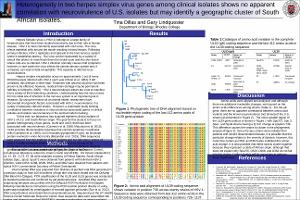Please use this identifier to cite or link to this item:
http://hdl.handle.net/10267/33459Full metadata record
| DC Field | Value | Language |
|---|---|---|
| dc.contributor.advisor | Lindquester, Gary J. | - |
| dc.contributor.author | Dillas, Tina | - |
| dc.date.accessioned | 2018-05-10T15:38:50Z | - |
| dc.date.available | 2018-05-10T15:38:50Z | - |
| dc.date.issued | 2018-04-27 | - |
| dc.identifier.uri | http://hdl.handle.net/10267/33459 | - |
| dc.description | Presentation by Tina Dillas ('18) delivered at the Rhodes College Undergraduate Research and Creative Activity Symposium (URCAS). | en_US |
| dc.description.abstract | Herpes simplex virus 1 (HSV-1) is a neuroinvasive human pathogen that evades host immune responses and results in life-long infection. Primary infections generally occur around the mouth and lips from viral transmission though oral secretions. Following infection, HSV-1 spreads to the host nervous system and establishes latency. The virus’s ability to reactivate infection depends on the site of infection, virus strain, and host immunity. HSV-1 infection normally causes mild symptoms; however, in rare cases the virus enters the central nervous system and, if untreated, can lead to fatal encephalitis. The purpose of this study was to explore genetic variation in HSV-1 and consider how frequently differences that may contribute to central nervous system virulence occur in circulating viral strains.Twenty-two HSV strains were obtained from collaborators at the Centers for Disease Control and Prevention. These strains vary in their neurovirulence as determined previously in mouse studies. Here, we assessed variation in the DNA sequences of two viral genes designated UL39 and UL53 (encoding ribonucleotide reductase and glycoprotein K, respectively) due to their involvement in HSV-1 neurovirulence. Sequences of these genes from the twenty-two viral strains were compared to identify variations that correlate with high or low neurovirulence. | en_US |
| dc.publisher | Memphis, Tenn. : Rhodes College | en_US |
| dc.rights | Rhodes College owns the rights to the archival digital images in this repository. Images are made available for educational use only and may not be used for any non-educational or commercial purpose. Approved educational uses include private research and scholarship, teaching, and student projects. For additional information please contact archives@rhodes.edu. Fees may apply. | - |
| dc.subject | URCAS | en_US |
| dc.subject | Class of 2018 | en_US |
| dc.subject | Student research | en_US |
| dc.subject | 2018 Spring | en_US |
| dc.subject | Biology, Department of | en_US |
| dc.title | Sequence variability in UL39 and UL53 genes of Herpes simplex virus 1 may contribute to neurovirulence | en_US |
| Appears in Collections: | Undergraduate Research and Creative Activity Symposium | |
Files in This Item:
| File | Description | Size | Format | |
|---|---|---|---|---|
| 201804_Dillas_HerpesVirus_poster.pdf | 264.21 kB | Adobe PDF |  View/Open |
Items in DSpace are protected by copyright, with all rights reserved, unless otherwise indicated.